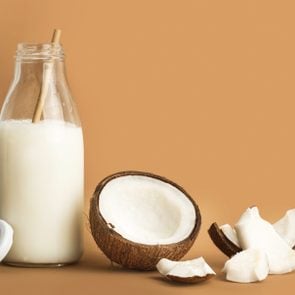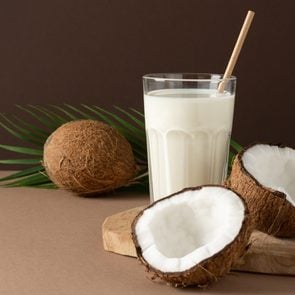4 Substitutes You Can Use for Coconut Milk
Updated: Sep. 15, 2021
Don't have coconut milk on hand for your favorite curry? Try one of these expert-approved substitutes instead.
Our editors and experts handpick every product we feature. We may earn a commission from your purchases.
Coconut milk 101
These days, coconut milk is seemingly everywhere—from pineapple smoothie recipes to curries and more. And for good reason, as the plant-based milk is creamy and absolutely delicious.
“Coconut milk is slightly sweet, nutty, and creamy,” says Breanna Woods, a registered dietitian in Indianapolis, Indiana. Of course, different types of coconut milk exist.
It’s important to understand the differences in coconut milks you can find at the store, according to registered dietitian nutritionist Jen Hernandez, founder of Plant-Powered Kidneys in the Louisville, Kentucky area.
“There is ready-to-drink coconut milk, which is either refrigerated or shelf-stable and in a carton,” Hernandez says. “This is essentially watered-down coconut milk. Then, there is canned coconut milk. This is much richer and thicker.”
Coconut milk is often a top pick because it boasts many nutritional benefits.
“Full-fat canned coconut milk contains antioxidants, as well as vitamins, minerals, and some protein,” says Elizabeth Brown, a registered dietitian nutritionist and certified holistic chef in Santa Monica, California.
“You also get copper, iron, magnesium, manganese, phosphorus, potassium, selenium, and zinc.”
Coconut milk nutrition information
One cup of coconut milk contains:
- Calories: 78
- Protein: 1 gram
- Fat: 5 grams
- Saturated fat: 5 grams
- Carbohydrates: 7 grams
- Fiber: 0 grams
In addition to fans in the plant-based community, coconut milk is often a go-to drink for people with diabetes.
“Many people with diabetes are drawn to coconut milk because it can be lower in carbohydrates when compared to dairy milk,” says registered dietitian Toby Smithson, author of Diabetes Meal Planning and Nutrition for Dummies.
Still, if a recipe calls for coconut milk, you can use a coconut milk substitute if you don’t have the liquid on hand, if you have a coconut allergy, or if you just don’t love the taste of coconut. Here’s what you need to know.
How to substitute coconut milk
Ready to sub out coconut milk in your favorite dish? When choosing a replacement, first think about how you’ll be using your coconut milk substitute.
“For example, if you are swapping out coconut milk with another milk for your cereal, you probably want something thin and likely unsweetened to keep the sugar content of your cereal bowl down,” says Hernandez.
On the other hand, you might have a different train of thought if you’re looking to substitute canned coconut milk in recipes like soups, stews, or sauces. In these cases, you might want to choose something with a thicker consistency.
When it comes to coconut milk substitutes, there are so many options—from plant-based milks to yogurts to even tofu. Let’s take a look at what top nutrition experts recommend.
Coconut milk substitute: soy milk
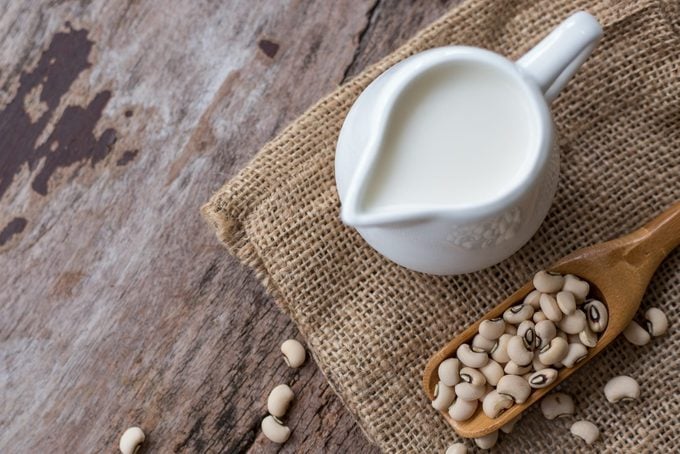
Soy milk is one of the most popular plant-based beverages out there, as well as top substitute for coconut milk.
It’s a good source of protein and is fairly low in carbohydrates. This protein makes soy milk a good substitute for active folks aiming to build or maintain lean muscle mass, adds registered dietitian Mary-Catherine LaBossiere, owner of Defy Nutrition in Clarksville, Tennessee.
Plus, you’ll find many soy milk options out there that are unsweetened—which means they don’t contain any added sugars. This is a nutritional plus.
“Soy milk is typically calcium-fortified, meaning that calcium is added to the milk during processing,” says LaBossiere.
“Since dairy is the primary source of calcium in our diets, soy milk can be a great plant-based way to work toward our daily calcium goals without having to drink [dairy] milk.”
How soy milk is made
“Soy milk is traditionally made by soaking soybeans in water, then grinding the soybeans with additional water,” explains LaBossiere.
“Manufacturers may use slightly different practices. But nowadays, soybeans are typically cleaned, steamed, and dehulled to remove the outer part or hull of the bean, blanched, ground in a hot-water solution, filtered, mixed with water, flavored, fortified, and homogenized.”
The homogenization process is what makes all the components of the soy milk stay together—making it the creamy beverage you’re familiar with. “Lastly, soy milk is pasteurized or treated with high temperatures to ensure safe storage,” adds LaBossiere.
Soy milk nutritional notes
Soy milk contains 105 calories, 6 grams protein, 4 grams fat, .5 gram saturated fat, 12 grams carbohydrates, and .5 gram fiber per cup, per the USDA.
“The heart-healthy fiber and fat in soy milk contribute to satiety, helping you to stay full for longer,” says LaBossiere. “Protein is important for rebuilding and repairing our muscles, particularly important for anyone trying to build or maintain their lean muscle mass.”
Soy milk also boasts many other nutrients. “Calcium-fortified soy milk may contain up to 300 milligrams of calcium per cup,” says LaBossiere.
This is 23 percent of the daily value (DV), making it an excellent source. “Calcium has many roles in the body, to include supporting bone and teeth health,” she notes.
How soy milk differs from coconut milk
Boxed coconut milk and soy milk have similar consistencies. And some experts would choose soy milk if given the option.
“I prefer the consistency of soy milk and that it is easier to find soy milk that is nutritionally comparable to cow’s milk,” says registered dietitian nutritionist Rosa Lopez, MD, founder of Healthy Deconstructed, in New Mexico.
Of course, soy and coconut milks differ nutritionally.
“Coconut milk, by nature, has a higher fat content than soy milk,” says LaBossiere.
“For this reason, it tends to have a somewhat thicker texture. Because of its fat content, coconut milk is great for creamier dishes. Soy milk, with its more liquid consistency, doesn’t always thicken well.”
This makes soy milk better suited for recipes such as smoothies and baked goods.
When to substitute soy milk for coconut milk
Perhaps soy milk’s best-known use is as a substitute for dairy milk for both drinking and in the cereal bowl. It also makes a mean frothy lattes. And both LaBossiere and Lopez enjoy cooking with soy milk.
“Because soy milk has a high protein content, baked goods with soy milk tend to brown nicely and look similar in appearance to those made with dairy milk,” says LaBossiere. “I personally like to use soy milk in a DIY Alfredo recipe in lieu of store-bought Alfredo sauce.”
Soy milk also works well as a substitute in creamy smoothies and baked goods such as vegan chocolate cupcakes.
Coconut milk substitute: almond milk
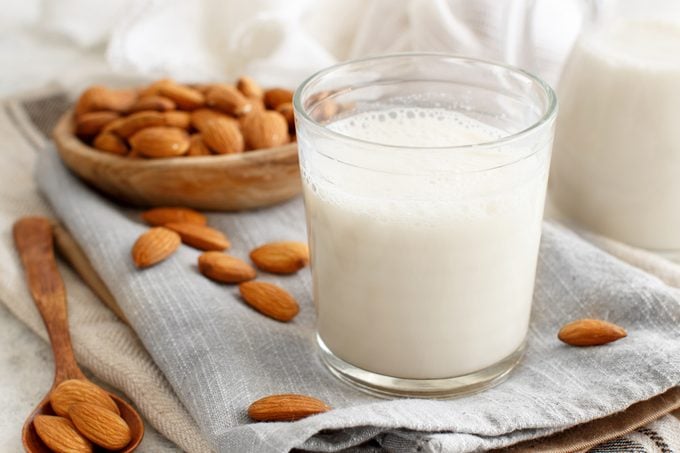
Almond milk is very comparable to soy milk as a plant-based coconut milk substitute.
“Almond milk is a good substitute for coconut milk because it has less calories and fat,” says registered dietitian Diane M. Nash, of Plymouth County, Massachusetts.
“It also does not contain saturated fat, while coconut milk does.” Indeed, a cup of almond milk only contains 41 calories and 3 grams fat.
The downside: Almond milk isn’t exactly high in protein: “It only contains 1 gram of protein per serving,” says Nash. “This is higher, however, than the 0 grams contained in coconut milk.”
How almond milk is made
The process for making almond milk is pretty darn simple. “Almond milk is made from blending almonds with water, then straining the mixture to remove the solids,” says Nash.
Almond milk nutritional notes
Per the USDA, almond milk contains 41 calories, 1 gram protein, 3 grams fat, 0 grams saturated fat, 2 grams carbohydrates, and 1 gram of fiber per cup.
This low carbohydrate content makes it another top choice for people with diabetes. You can easily find unsweetened almond milk, which contains no added sugars.
Almond milk boasts vitamin E. “This is an antioxidant that fights free radical damage—and it helps protect against heart disease and cancer,” says Nash.
How almond milk differs from coconut milk
“If you are watching your weight, cholesterol, and calories, then almond milk is the better choice as a milk substitute,” says Nash. Almond milk is all around a lighter pick.
Its consistency is comparable to that of skim milk, notes registered dietitian nutritionist Claire Lozano, of the greater Orlando, Florida area.
“Almond milk is thinner and not as rich and creamy as coconut milk.” So whereas almond milk would work very well in a smoothie, it may not work as well in certain other dishes such as creamy casseroles or curries.
When to substitute almond milk for coconut milk
“Almond milk is a great low-fat substitute to use with cereal, when baking, or to add to a roux when making a cream sauce or a cream-based soup for a lighter result,” says Lozano.
You can also readily swap it out for many plant-based milks in baked-good recipes such as muffins and quick breads. Plus, it works extremely well in overnight oats, as well as French toast.
Coconut milk substitute: Greek yogurt
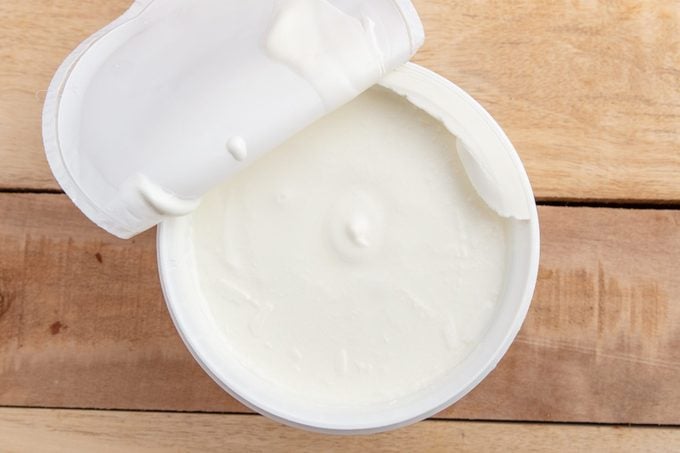
Greek yogurt is a great option to substitute for creamy canned coconut milk for folks who eat dairy.
“Greek yogurt is thick and adds creaminess to recipes, especially if you choose a full-fat variety,” says Woods. Greek yogurt has a tangy taste, which may not work well in every single recipe.
Also, obviously, Greek yogurt is not vegan. So if that’s important to you, you may want to choose a plant-based substitute for coconut milk such as silken tofu.
How Greek yogurt is made
The process for making Greek yogurt begins with milk. “Greek yogurt comes from fermented milk that’s been strained to remove the whey—or liquid parts—leaving behind a firm, thick yogurt,” says St Louis, Missouri registered dietitian nutritionist Gabrielle McPherson.
(Here’s how to try cooking with Greek yogurt.)
Greek yogurt nutritional notes
Low-fat plain Greek yogurt contains 146 calories, 20 grams protein, 4 grams fat, 2 grams saturated fat, 8 grams carbohydrates, and 0 grams fiber per a 7-ounce serving, according to the USDA.
“Greek yogurt works well as a substitute for coconut milk because it offers a substantial amount more protein, a nutrient of significance for those following plant-based lifestyles,” says McPherson.
It also provides a significant amount of calcium—230 milligrams, or 18 percent of the DV per serving.
How Greek yogurt differs from coconut
When it comes to consistency, Greek yogurt comes closer to canned coconut milk than the boxed version. It’s actually a little bit thicker, so if you’re looking to substitute it for canned coconut milk in something like a soup recipe, you may need to add more water.
Greek yogurt has a tangier taste than coconut milk, but this can work really well in recipes like smoothies, muffins, and overnight oats.
When to substitute Greek yogurt for coconut milk
“For a soup or smoothie recipe, you can replace coconut milk with yogurt at a one-to-one ratio, but keep in mind your recipe may need additional liquid,” notes McPherson.
You can also easily top pancakes or French toast with Greek yogurt instead of the coconut cream from canned coconut milk.
And Greek yogurt also works particularly well as a substitute in veggie dips, baked goods such as healthy muffins, and also banana-based smoothies. When substituting Greek yogurt for coconut milk, always choose plain yogurt.
Coconut milk substitute: silken tofu
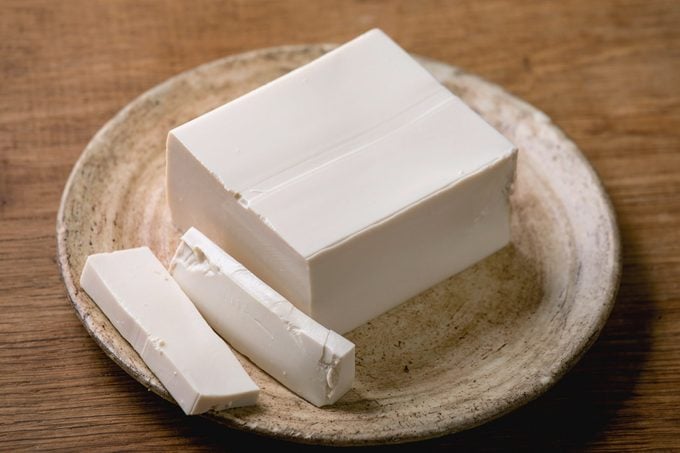
“Swapping silken tofu for a plant-based milk is a great way for someone to boost the protein content of a given recipe,” says Jenna Volpe, a functional registered dietitian nutritionist and clinical herbalist.
“Tofu’s flavor is also more versatile, compared to that of coconut. This can be an advantage if you don’t want your recipe to have a strong coconut flavor.”
Tofu picks up the flavor of what it’s surrounded within a recipe, making it a great neutral ingredient. Like Greek yogurt, silken tofu adds a thick, creamy texture to recipes.
How silken tofu is made
“Silken tofu is made from coagulated soy milk,” explains Sheri Berger, the registered dietitian nutritionist for the Cardiac and Pulmonary Wellness Center at El Camino Hospital in Mountain View, California.
“It is different from other forms of tofu because it has a higher water content, it is undrained, unpressed, and has a pudding- or custard-like consistency.”
Silken tofu nutritional notes
Per the USDA, silken tofu contains 151 calories, 18 grams protein, 9 grams fat, 1 gram of saturated fat, 3 grams carbohydrates, and .5 gram fiber per cup.
“Silken tofu offers protein and calcium,” says Berger. Per one-cup serving, silken tofu contains 275 milligrams calcium, or 22 percent DV.
Volpe notes that silken tofu is a very nutrient-dense food,
“First and foremost, it’s high in protein. Silken tofu is also a natural source of complete protein, as it contains all nine essential amino acids,” Volpe says.
“It also provides vitamins and minerals, including potassium, manganese, selenium, calcium, B vitamins, and iron. And it doesn’t contain fillers or added sugars like many commercial plant-based milks out there!”
(These are the other tofu health benefits to know.)
How silken tofu differs from coconut
“Silken tofu has a bland taste, and it will take on the flavors of other ingredients in the recipe,” says Berger.
“If you want the silken tofu to taste like coconut, add coconut extract! Since silken tofu is a bit thicker than coconut milk, you can use less when subbing it. Generally, two Tablespoons of silken tofu will replace a quarter cup of coconut milk.”
When to substitute silken tofu for coconut milk
Silken tofu isn’t always a straight substitute in recipes. “For foods like curry, soups, or smoothies, you might want to add soy or almond milk to thin out the silken tofu a bit,” says Woods.
The ingredient will work great as a substitute in recipes like vegan mousses, puddings, dairy-free Alfredo sauce, and smoothies, according to Volpe. “It may also be a good substitute for plant-based ice cream for people who don’t like the strong flavor of coconut or who have a nut allergy,” she says.
Now that you know about these coconut milk substitute options, check out these coconut milk recipes.

